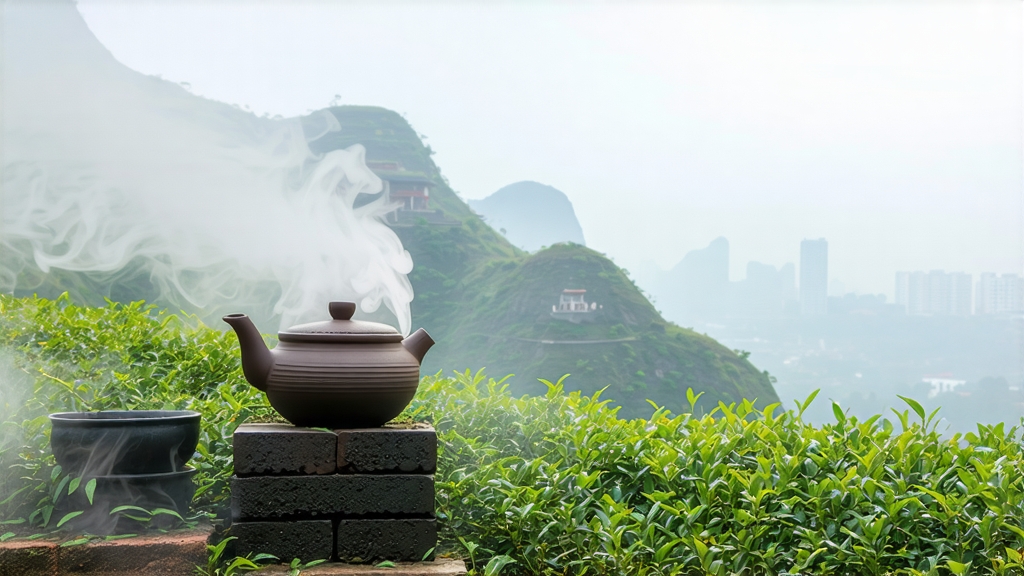
Tucked away in the southwestern folds of China’s Guangxi Zhuang Autonomous Region, the small town of Liubao has given its name to one of the oldest yet least-celebrated styles of dark tea in the world. While Pu-erh has become a global shorthand for aged, microbially fermented tea, Liu Bao—its quieter, more humid cousin—has spent centuries ferrying southward along the same river arteries that once carried spices, rice and inked imperial edicts. Today, as specialty cafés from Brooklyn to Berlin scramble to expand their post-fermented repertoires, Liu Bao is stepping out of the shadows, offering drinkers a softer, sweeter gateway into the deep, loamy universe of Chinese heicha.
A 1,500-year river town history
The first written record of “Liubao tea” appears in a 1567 county gazetteer that lists local tribute goods sent to the Ming court, but folk memory pushes the story back to the Tang dynasty (618-907). Caravans departing Liubao hugged the Wuzhou section of the Xun River, merged with the Pearl River delta, and within weeks docked at Guangzhou’s foreign warehouses. From there, bricks and baskets of Liu Bao sailed to Hong Kong, Macau, Southeast Asia and, by the early nineteenth century, the docks of London where it was catalogued as “China black tea, Liubao variety.” In Malaya, tin-mine coolies drank it with condensed milk to ward off malaria; in Guangzhou’s dim-sum halls, it was poured from long-spouted kettles to cut through pork fat. Thus, long before the concept of “terroir” became fashionable, Liu Bao had already become a transnational beverage, its flavour shaped as much by humid cargo holds as by the limestone soils of the Dayao Mountains.
From leaf to liangxiang: the craft today
Modern Liu Bao is made from the same Yunnan-large-leaf genetic pool that feeds Pu-erh, but the climate and processing give it a distinct identity. The picking season runs from mid-April to late-September, when two leaves and a bud are plucked from bushes that grow between 300–800 m along red, iron-rich slopes. After a brief outdoor withering, the leaves are wok-fired at 200 °C for three to four minutes—long enough to kill green enzymes but short enough to retain moisture for the crucial wet-piling phase.
The pile: Guangxi’s answer to composting
Where Yunnan’s Pu-erh relies on relatively dry, altitude-cooled fermentation, Liu Bao is subjected to a more tropical “wo dui.” The leaves are heaped 60–80 cm high inside spotless cement rooms, sprayed with mountain spring water, and covered with jute sacks and rice-husks. Internal temperature climbs to 55 °C within 24 hours; every two days the pile is turned by barefoot workers who judge readiness by aroma alone—sweet hay, then damp timber, finally the coveted “betel-nut” note that signals the end of primary fermentation after 10–15 days. The tea is then sun-dried on bamboo racks for another three days, reducing moisture to 10 % and locking in a mahogany colour that will deepen over decades.
Basket ageing: the second life
Unlike Pu-erh bings, Liu Bao is traditionally packed into 40–50 kg cylindrical bamboo baskets lined with wild banana leaves. These baskets breathe; over years they allow a slow secondary fermentation driven by indigenous microbes—Bacillus subtilis, Aspergillus niger and a Guangxi-specific yeast dubbed Candida liubaoensis. Tea traders store the baskets in riverside warehouses where humidity hovers at 75 % and temperatures oscillate between 20 °C in winter and 30 °C in summer. After five years the liquor turns chestnut-brown; after fifteen it acquires a ruby glint and the fragrance of camphor and longan. Connoisseurs speak of “three treasures” in aged Liu Bao: the betel-nut aroma, the golden ring that clings to the cup rim, and the sweet, cooling “liangxiang” that lingers at the back of the throat long after the last sip.
Tasting the decades: a flight protocol
To introduce Liu Bao to an international audience, treat it like a vertical whisky tasting. You will need three expressions: a 2-year “young” basket for brightness, a 7-year for balance, and a 15-year for depth. Use a 120 ml Yixing clay